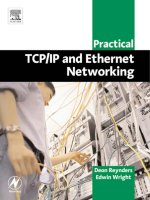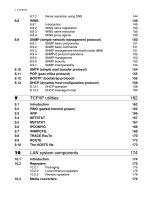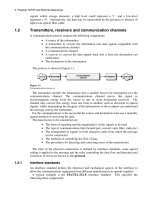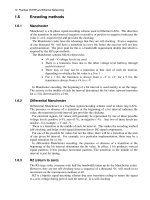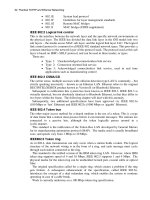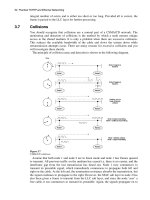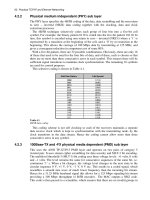Practical TCP/IP and Ethernet Networking- P8 doc
Bạn đang xem bản rút gọn của tài liệu. Xem và tải ngay bản đầy đủ của tài liệu tại đây (144.3 KB, 5 trang )
4KZ]UXQOTML[TJGSKTZGRY
)OXI[OZY]OZINOTM
In a circuit switched process a continuous connection is made across the network between
the two different points. This is a temporary connection, which remains in place as long
as both parties wish to communicate, that is until the connection is terminated. All the
network resources are available for the exclusive use of these two parties whether they
are sending data or not. When the connection is terminated the network resources are
released for other users. A telephone call is an example of a circuit switched connection.
The advantage of circuit switching is that the users have an exclusive channel available
for the transfer of their data at any time while the connection is made. The obvious
disadvantage is the cost of maintaining the connection when there is little or no data being
transferred. Such connections can be very inefficient for the bursts of data that are
typical of many computer applications.
6GIQKZY]OZINOTM
Packet switching systems improve the efficiency of the transfer of bursts of data, by
sharing the one communications channel with other similar users. This is analogous to
the efficiencies of the mail system as discussed in the following paragraph.
When you send a letter by mail you post the stamped, addressed envelope containing
the letter in your local mailbox. At regular intervals the mail company collects all the
letters from your locality and takes them to a central sorting facility where the letters are
sorted in accordance with the addresses of their destinations. All the letters for each
destination are sent off in common mailbags to those locations, and are subsequently
delivered in accordance with their addresses. Here we have economies of scale where
many letters are carried at one time and are delivered by the one visit to your
street/locality. Efficiency is more important than speed, and some delay is normal –
within acceptable limits.
Packet switched messages are broken into a series of packets of certain maximum size,
each containing the destination and source addresses and a packet sequence number. The
packets are sent over a common communications channel, possibly interleaved with those
of other users. All the receivers on the channel check the destination addresses of all
packets and accept only those carrying their address. Messages sent in multiple packets
are reassembled in the correct order by the destination node.
All packets do not necessarily follow the same path. As they travel through the
network they may get separated and handled independently from each other, but
eventually arrive at their correct destination. For this reason, packets often arrive at the
destination node out of their transmitted sequence. Some packets may even be held up
temporarily (stored) at a node, due to unavailable lines or technical problems that might
arise on the network. When the time is right, the node then allows the packet to pass or
be ‘forwarded’.
*GZGMXGSYGTJ\OXZ[GRIOXI[OZY
Packet switched services generally support two types of service viz. datagrams and
virtual circuits.
In a self contained local area network all packets will eventually reach their destination.
However, if the packet is to be switched ACROSS networks i.e. on an internetwork –
such as a wide area network – then a routing decision must be made.
There are two approaches that can be taken. The first is referred to as a DATAGRAM
service. The approach is to allow each packet to be independently routed. The destination
6XGIZOIGR:)6/6GTJ+ZNKXTKZ4KZ]UXQOTM
address incorporated in the data header will allow the routing to be performed. There is
no guarantee when any packet will arrive at its destination, and they may well be out of
sequence. The principle is similar to the mail service. You may send four postcards from
your holiday in the South of France, but there is no guarantee that they will arrive in the
same order that you posted them. If the recipient does not have a telephone, there is no
easy method of determining that they have, in fact, been delivered. Such a service is
called an UNRELIABLE service. This word is not used in its everyday context, but
rather refers to the fact that there is no mechanism for informing the sender that the
packet had not been delivered. The service is also called connectionless since a
connection is not made for each packet.
The second approach is to setup a connection between transmitter and receiver, and to
send all packets of data along this connection or VIRTUAL CIRCUIT. Whilst this
might seem to be in conflict with the earlier statements on circuit switching, it should be
quite clear that this does NOT imply a permanent circuit being dedicated to the one
packet stream of data. Rather, the circuit shares its capacity with other traffic. The
important point to note is that the route for the data packets to follow is taken up-front
when all the routing decisions are taken. The data packets just follow that pre-established
route. This service is known as RELIABLE and is also referred to as a connection
oriented service or COS.
:_VKYULTKZ]UXQY
2UIGRGXKGTKZ]UXQY2'4Y
LANs are characterized by high-speed transmission over a restricted geographical area.
Thick Ethernet (10Base5), for example, operates at 10 Mb/s over a maximum distance of
500 m before the signals need to be boosted. This is illustrated in Figure 2.2.
Figure 2.2
Example of LAN
=OJKGXKGTKZ]UXQY='4Y
While LANs operate where distances are relatively small, wide area networks (WANs)
are used to link LANs that are separated by large distances that range from a few tens of
meters to thousands of kilometers. WANs normally use the public telecommunication
system to provide cost-effective connection between LANs. Since these links are supplied
by independent telecommunications utilities, they are commonly referred to (and
illustrated as) a ‘communications cloud’. Special equipment called gateways have been
developed for this type of activity, which store the message at LAN speed and transmit it
across the ‘communications cloud’ at a lower speed. When the entire message has been
received at the remote LAN, the message is reinserted at LAN speed. A typical speed at
which a WAN interconnects is 9600 bps to 45 Mbps. This is shown in Figure 2.3.
4KZ]UXQOTML[TJGSKTZGRY
Figure 2.3
WAN concept
If reliability is needed for a time critical application, WANs can be considered quite
unreliable, as delay in the information transmission is varied and wide. For this reason,
WANs can only be used if the necessary error detection/ correction software is in place,
and if propagation delays can be tolerated within certain limits.
3KZXUVUROZGTGXKGTKZ]UXQY3'4Y
An intermediate type of a network – MANs – operate at speeds ranging from 56 kbps to
100Mbps – typically a higher speed than WANs but slower than LANs. MANs use fiber
optic technology to communicate over distances of up to several hundred kilometers.
They are normally used by telecommunication service providers within cities.
)U[VROTMXGZOU
The coupling ratio provides an academic yardstick for comparing the performance of
these different kinds of networks. It is useful to give us an insight as to the way that each
network needs to operate.
Coupling ratio α = τ / T
Where
τ Propagation delay for packet
T Average packet transmission time
α =<<1 indicates a LAN
α = 1 indicates a MAN
α =>>1 indicates a WAN
This is illustrated in the following examples and Figure 2.4.
200 m LAN: With a propagation delay of about 1 mS, a 1000 byte packet takes about
0.8 ms to transmit at 10 Mbps.
Therefore α is about 1 mS/0.8 ms or 1/800 which is very much less than 1. This means
that for a LAN the packet quickly reaches the destination and the transmission of the
packet then takes say hundreds of times longer to complete.
200 km MAN: With a propagation delay of about 1 mS, a 4000 byte packet takes
about 0.4 ms to transmit at 100 Mbps.
Therefore α is about 1 mS/0.4 ms or 2.4 which is about the order of 1. This means that
for a MAN the packet reaches the destination then may only take about the same time
again to complete the transmission.
6XGIZOIGR:)6/6GTJ+ZNKXTKZ4KZ]UXQOTM
100 000 km WAN: Propagation delay about 0.5–2 seconds, a packet of 128 bytes
takes about 10 ms to transmit at 1 Mbps.
Therefore α is about 1 S/10 ms or 100. This means that for a WAN the packet reaches
the destination after a delay of 100 times the packet length.
Figure 2.4
Coupling ratios
<OXZ[GRVXO\GZKTKZ]UXQY<64Y
A cheaper alternative to a WAN, which uses dedicated packet switched links (such as
X.25) to interconnect two or more LANs, is the virtual private network, which
interconnects several LANs by utilizing the existing Internet infrastructure.
A potential problem is the fact that the traffic between the networks shares all the other
Internet traffic and hence all communications between the LANs are visible to the outside
world. This problem is solved by utilizing encryption techniques to make all
communications between the LANs transparent (i.e. illegible) to other Internet users.
:NKUVKTY_YZKSYOTZKXIUTTKIZOUTSUJKR
A communication framework that has had a tremendous impact on the design of LANs is
the open systems interconnection (or OSI) model. The objective of this model is to
provide a framework for the coordination of standards development and allows both
existing and evolving standards activities to be set within that common framework.
5VKTGTJIRUYKJY_YZKSY
The wiring together of two or more devices with digital communication is the first step
towards establishing a network. In addition to the hardware requirements, which have
been discussed above, the software problems of communication must also be overcome.
Where all the devices on a network are from the same manufacturer, the hardware and
software problems are usually easily overcome because the system is usually designed
within the same guidelines and specifications.
When devices from several manufacturers are used on the same application, the
problems seem to multiply. Networks that are specific to one manufacturer and which
work with specific hardware connections and protocols are called closed systems.
Usually, these systems were developed at a time before standardization or when it was
4KZ]UXQOTML[TJGSKTZGRY
considered unlikely that equipment from other manufacturers would be included in
the network.
In contrast, open systems are those, which conform to specifications and guidelines,
which are ‘open’ to all. This allows equipment from any manufacturer, who claims to
comply with that standard, to be used interchangeably on the standard network. The
benefits of open systems include wider availability of equipment, lower prices and easier
integration with other components.
:NKUVKTY_YZKSYOTZKXIUTTKIZOUTXKLKXKTIKSUJKR59/SUJKR
Faced with the proliferation of closed network systems, in 1978 the International
Standards Organization (ISO) defined a ‘Reference Model for Communication between
Open Systems’, which has become known as the open systems interconnection (OSI)
model, or simply as the ISO/OSI model (ISO 7498). OSI is essentially a data
communications management structure, which breaks data communications down into a
manageable hierarchy of seven layers. Each layer has a defined purpose and interfaces
with the layers above it and below it. By laying down standards for each layer, some
flexibility is allowed so that the system designers can develop protocols for each layer
independent of each other. By conforming to the OSI standards, a system is able to
communicate with any other compliant system, anywhere in the world.
It should be realized at the outset that the OSI reference model is not a protocol or set
of rules for how a protocol should be written but rather an overall framework in which to
define protocols. The OSI model framework specifically and clearly defines the
functions or services that have to be provided at each of the seven layers (or levels).
Since there must be at least two sites to communicate, each layer also appears to
converse with its peer layer at the other end of the communication channel in a virtual
(‘logical’) communication. These concepts of isolation of the process of each layer,
together with standardized interfaces and peer-to-peer virtual communication, are
fundamental to the concepts developed in a layered model such as the OSI model. The
OSI layering concept is shown in Figure 2.5.
Figure 2. 5
OSI layering concept
The actual functions within each layer are provided by entities which are abstract
devices, such as programs, functions, or protocols, that implement the services for a
particular layer on a single machine. A layer may have more than one entity – for
example a protocol entity and a management entity. Entities in adjacent layers interact
